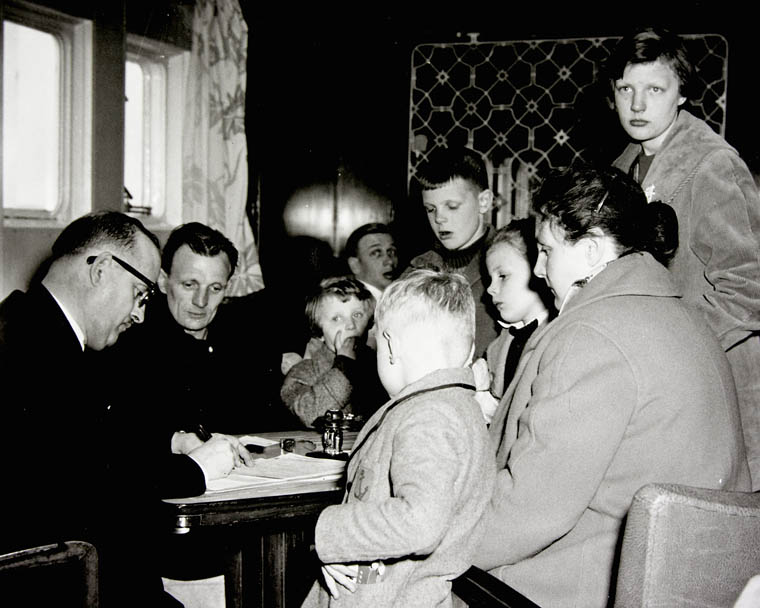Browse "Immigrants and Refugees"
-
Article
Child Migration to Canada
Migration is a unique experience for a child and Canada receives child migrants from all over the world. Some children come as unaccompanied minors and claim refugee status, some come alone and wait to be reunited with their families, while others are international adoptees by Canadian families.
"https://d2ttikhf7xbzbs.cloudfront.net/media/media/55e0c503-e9cf-4fb3-852d-7776eb9d9871.jpg" // resources/views/front/categories/view.blade.php
https://d2ttikhf7xbzbs.cloudfront.net/media/media/55e0c503-e9cf-4fb3-852d-7776eb9d9871.jpg
-
Article
Chinese Canadians
Chinese Canadians are one of the largest ethnic groups in the country. In the 2021 census, more than 1.7 million people reported being of Chinese origin. Despite their importance to the Canadian economy, including the construction of the Canadian Pacific Railway (CPR), many European Canadians were historically hostile to Chinese immigration. A prohibitive head tax restricted Chinese immigration to Canada from 1885 to 1923. From 1923 to 1947, the Chinese were excluded altogether from immigrating to Canada. (See Chinese Immigration Act.) Since 1900, Chinese Canadians have settled primarily in urban areas, particularly in Vancouver and Toronto. They have contributed to every aspect of Canadian society, from literature to sports, politics to civil rights, film to music, business to philanthropy, and education to religion. This is the full-length entry about Chinese Canadians. For a plain-language summary, please see Chinese Canadians (Plain-Language Summary).
"https://d2ttikhf7xbzbs.cloudfront.net/media/media/bff27f89-2e99-43af-a42e-36f38dbcdf8d.jpg" // resources/views/front/categories/view.blade.php
https://d2ttikhf7xbzbs.cloudfront.net/media/media/bff27f89-2e99-43af-a42e-36f38dbcdf8d.jpg
-
Article
Chinese Head Tax in Canada
The Chinese head tax was enacted to restrict immigration after Chinese labour was no longer needed to build the Canadian Pacific Railway. Between 1885 and 1923, Chinese immigrants had to pay a head tax to enter Canada. The tax was levied under the Chinese Immigration Act (1885). It was the first legislation in Canadian history to exclude immigration on the basis of ethnic background. With few exceptions, Chinese people had to pay at least $50 to come to Canada. The tax was later raised to $100, then to $500. During the 38 years the tax was in effect, around 82,000 Chinese immigrants paid nearly $23 million in tax. The head tax was removed with the passing of the Chinese Immigration Act in 1923. Also known as the Chinese Exclusion Act, it banned all Chinese immigrants until its repeal in 1947. In 2006, the federal government apologized for the head tax and its other racist immigration policies targeting Chinese people. This is the full-length entry about the Chinese Head Tax. For a plain-language summary, please see Chinese Head Tax in Canada (Plain-Language Summary).
"https://d2ttikhf7xbzbs.cloudfront.net/media/media/876dbb1e-74e3-4cfe-b961-a6d31d296fd6.jpg" // resources/views/front/categories/view.blade.php
https://d2ttikhf7xbzbs.cloudfront.net/media/media/876dbb1e-74e3-4cfe-b961-a6d31d296fd6.jpg
-
Article
Chinese Immigration Act
The Chinese Immigration Act of 1923, known also as the Chinese Exclusion Act, banned the entry of virtually all Chinese immigrants for 24 years. Although migration into Canada from most countries was controlled or restricted in some way, only Chinese people were singled out completely from entering on the basis of race. The four exceptions to the exclusion were students, merchants (excluding laundry, restaurant and retail operators), diplomats and Canadian-born Chinese returning from education in China. The limit on absence from Canada was two years, and the consequence for not returning on time was being barred re-entry. Additionally, every person of Chinese descent, whether Canadian-born or naturalized, was required to register for an identity card within 12 months. The penalty for noncompliance was imprisonment or a fine of up to $500. Though the Act was repealed in 1947, immigration restrictions on the basis of race and national origin were not fully scrubbed until 1967.
"https://d2ttikhf7xbzbs.cloudfront.net/media/media/d0c5f1d6-6030-4a96-900c-3efed6463116.jpg" // resources/views/front/categories/view.blade.php
https://d2ttikhf7xbzbs.cloudfront.net/media/media/d0c5f1d6-6030-4a96-900c-3efed6463116.jpg
-
Article
Croatian Canadians
Croatia is a country in southeastern Europe. It is bordered by Slovenia, Hungary, Serbia, Bosnia-Herzegovina, Montenegro and the Adriatic Sea. The first Croatians to set foot on the land known today as Canada may have been two sailors from Dalmatia. One, serving as crew on Jacques Cartier’s third voyage (1541-42) and another, a miner who accompanied Samuel De Champlain in his explorations (1604-06). The 2016 census reported 133, 970 people of Croatian origin in Canada (55, 595 single and 78, 370 multiple responses).
"https://development.thecanadianencyclopedia.ca/images/tce_placeholder.jpg?v=e9dca980c9bdb3aa11e832e7ea94f5d9" // resources/views/front/categories/view.blade.php
https://development.thecanadianencyclopedia.ca/images/tce_placeholder.jpg?v=e9dca980c9bdb3aa11e832e7ea94f5d9
-
Article
Czech Canadians
Canada is home to the third largest Czech diaspora after the United States and Germany. Today, Czech Canadians form an ethnocultural community with a rich history dating back to the 1880s.
"https://d2ttikhf7xbzbs.cloudfront.net/media/media/01894bbf-19ca-41e2-9c3b-304d15623d23.jpg" // resources/views/front/categories/view.blade.php
https://d2ttikhf7xbzbs.cloudfront.net/media/media/01894bbf-19ca-41e2-9c3b-304d15623d23.jpg
-
Article
Danish Canadians
The first Danish contact with the place we know today as Canada resulted from the voyage of Captain Jens Eriksen Munk, who had been dispatched by King Christian IV of Denmark in the early 17th century to find the Northwest Passage. In 2016, the Canadian census reported 207, 470 people of Danish origin (26, 990 single and 180, 485 multiple responses).
"https://d2ttikhf7xbzbs.cloudfront.net/media/new_article_images/DanishCanadians/Danish_Canadians.jpg" // resources/views/front/categories/view.blade.php
https://d2ttikhf7xbzbs.cloudfront.net/media/new_article_images/DanishCanadians/Danish_Canadians.jpg
-
Article
Doukhobors
Doukhobors are a sect of Russian dissenters, many of whom now live in western Canada. They are known for a radical pacifism which brought them notoriety during the 20th century. Today, their descendants in Canada number approximately 30,000, with one third still active in their culture.
"https://d2ttikhf7xbzbs.cloudfront.net/DCI-images/1908-Doukhobours-final-rescale.jpg" // resources/views/front/categories/view.blade.php
https://d2ttikhf7xbzbs.cloudfront.net/DCI-images/1908-Doukhobours-final-rescale.jpg
-
Article
Dutch Canadians
From the earliest years of the 17th century, the Dutch were engaged in the fur trade on the Hudson River. In 1614, they established trading posts on Manhattan Island and at Fort Orange (present-day Albany, New York). But only after the American Revolution (1775-1783) did Dutch immigration to British North America (now Canada) begin. The Dutch who had long been settled in the Thirteen Colonies fit easily into Canadian society. Since that time, Canada has experienced three waves of immigration from the Netherlands, the largest of them after the Second World War.
"https://d2ttikhf7xbzbs.cloudfront.net/media/media/36937a2a-48f7-4146-a170-649f7f3daaab.jpg" // resources/views/front/categories/view.blade.php
https://d2ttikhf7xbzbs.cloudfront.net/media/media/36937a2a-48f7-4146-a170-649f7f3daaab.jpg
-
Article
English Canadians
The English were among the first Europeans to reach Canadian shores. Alongside the French, they were one of two groups who negotiated Confederation. The expression “English Canadians” refers to both immigrants from England and the Loyalists in exile after the American Revolution and their descendants. According to the 2021 census of Canada, about 14.7 per cent of Canadians (5,322,830 respondents) consider themselves to be of English origin.
"https://d2ttikhf7xbzbs.cloudfront.net/media/media/99b475a0-4821-4f9d-89e1-dff3464ef8e9.jpg" // resources/views/front/categories/view.blade.php
https://d2ttikhf7xbzbs.cloudfront.net/media/media/99b475a0-4821-4f9d-89e1-dff3464ef8e9.jpg
-
Article
Estonian Canadians
The Republic of Estonia is a northern European country, located in the Baltic region. It is bordered by Finland, Sweden, Latvia, and the Russian Federation. The first Estonian settlement in Canada was established in 1899, near Sylvan Lake in central Alberta. The 2016 census reported 24, 530 people of Estonian origin in Canada (6155 single and 18, 375 multiple responses).
"https://development.thecanadianencyclopedia.ca/images/tce_placeholder.jpg?v=e9dca980c9bdb3aa11e832e7ea94f5d9" // resources/views/front/categories/view.blade.php
https://development.thecanadianencyclopedia.ca/images/tce_placeholder.jpg?v=e9dca980c9bdb3aa11e832e7ea94f5d9
-
Article
Filipino Canadians
Filipinos have been in Canada as early as the late 19th century. Migration from the Philippines to Canada significantly increased from the 1960s onward. (See Immigration to Canada.) In the 2021 census, 957,355 people reported being of Filipino ethnic origin. Filipino Canadians are the largest group of Southeast Asian Canadians. Among Filipino Canadians, women outnumber men by 55.3 per cent to 44.7 per cent. The Philippines is the third-largest country of origin for immigrants to Canada.
"https://d2ttikhf7xbzbs.cloudfront.net/Canada_Philippines_2.jpg" // resources/views/front/categories/view.blade.php
https://d2ttikhf7xbzbs.cloudfront.net/Canada_Philippines_2.jpg
-
Article
Finnish Canadians
Between 1835 and 1865, several hundred immigrants from Finland settled in Alaska (which was part of Russia at that time). Many moved down the coast to British Columbia (see Sointula). Some early Finnish immigrants to Ontario worked on the construction of the first Welland Canal, which was completed in 1829. The 2021 census reported 144,055 people of Finnish origin in Canada.
"https://d2ttikhf7xbzbs.cloudfront.net/media/new_article_images/FinnishCanadians/Finnish_immigrants_in_Rouyn,_Quebec,_Canada,_1926.png" // resources/views/front/categories/view.blade.php
https://d2ttikhf7xbzbs.cloudfront.net/media/new_article_images/FinnishCanadians/Finnish_immigrants_in_Rouyn,_Quebec,_Canada,_1926.png
-
Article
Fred Bruemmer
Friedrich Karl von Bruemmer, CM, RCA, photographer, writer, researcher (born 26 June 1929 in Riga, Latvia; died 17 December 2013 in Montreal, QC). Latvian Canadian wildlife photographer Fred Bruemmer spent much of his professional career in the Arctic. He was famous for photographing the flora and fauna of the North and the lifestyle of the Inuit. Bruemmer was a prolific writer and researcher who wrote more than 1,000 articles and 27 books. His extensive work in the circumpolar world reached an international audience. He was described in a 1980 Maclean’s article as “one of the least-known world-famous men in Canada.” He was made a Member of the Order of Canada in 1983.
"https://d2ttikhf7xbzbs.cloudfront.net/Fred_Bruemmer.jpg" // resources/views/front/categories/view.blade.php
https://d2ttikhf7xbzbs.cloudfront.net/Fred_Bruemmer.jpg
-
Article
Fred Rose
Fred Rose, union organizer, politician (b Fred Rosenberg at Lublin, Poland 7 Dec 1907; d at Warsaw, Poland 16 Mar 1983). Rose moved with his parents to Montréal. In the 1930s, as a member of the Young Communist League, he organized unions of unemployed and unskilled workers.
"https://d2ttikhf7xbzbs.cloudfront.net/media/media/61299676-2265-417c-a7a2-eff255a2056a.jpg" // resources/views/front/categories/view.blade.php
https://d2ttikhf7xbzbs.cloudfront.net/media/media/61299676-2265-417c-a7a2-eff255a2056a.jpg
